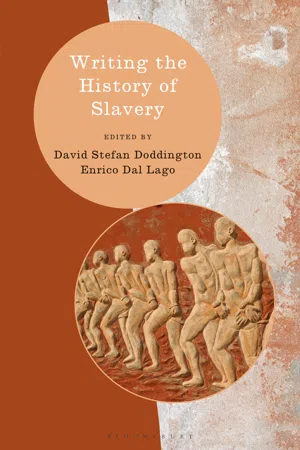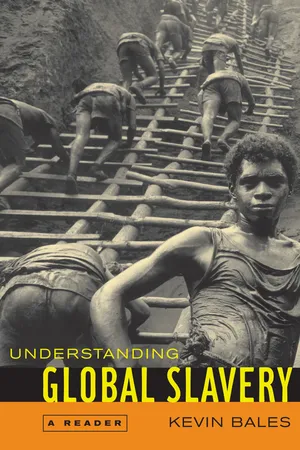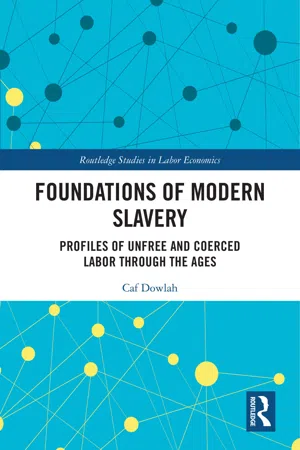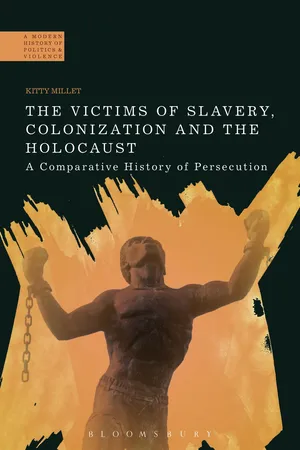History
History of Slavery
The history of slavery spans thousands of years and has been a widespread practice across various cultures and civilizations. It involves the ownership and exploitation of individuals as forced laborers, often under brutal and inhumane conditions. Slavery has had a profound impact on shaping societies, economies, and the course of human history.
Written by Perlego with AI-assistance
Related key terms
1 of 5
7 Key excerpts on "History of Slavery"
- eBook - ePub
- David Stefan Doddington, Enrico Dal Lago, David Stefan Doddington, Enrico Dal Lago(Authors)
- 2022(Publication Date)
- Bloomsbury Academic(Publisher)
Introduction: Writing the History of Slavery David Stefan Doddington and Enrico Dal Lago Cardiff University and National University Ireland Galway Slavery has existed almost everywhere around the globe where humans have laid roots, and most human societies have, at one point or another, either practised forms of slavery or faced enslavement themselves. 1 While varying widely across time and place, the seemingly ubiquitous place of slavery in the human past, and the legacies, memories and the global impact of slavery and enslavement – whether personal, political, social, cultural or economic – has meant that scholars studying a wide range of regions, themes and chronologies have been drawn to the topic. Taking inspiration from these scholars and from the massive body of work they have generated in the course of over a century of studies on the History of Slavery, with this volume we aim to delve into the historiographical, theoretical and methodological imperatives and approaches that have driven historians in their studies of both the institution of slavery and the process of enslavement across time and space. While we do not seek to explore the History of Slavery per se, nor focus on the lives of either the enslavers or the enslaved, we intend to provide a guide to how historians have used different concepts, ideas and methodologies in their efforts at reconstructing the experience of slavery by different categories of people in different times and places throughout human history. The historiography of slavery is large and immensely complicated, and, especially in the past forty years, it has expanded exponentially, often as a result of the ongoing significance of scholarly debates around particular issues - eBook - PDF
Understanding Global Slavery
A Reader
- Kevin Bales(Author)
- 2005(Publication Date)
- University of California Press(Publisher)
The past few years have seen the discovery of new forms of slavery. Researchers, journalists, and activists around the world have documented human tra Y cking in eastern Europe, debt bondage in South Asia, and short-term “contract” slavery in Brazil, as well as “classical” slavery in North Africa put to new uses. Organizations as diverse as the American Central Intelligence Agency, the Vatican, the United Nations, and Amnesty International have turned their attention to slavery. Slavery is not always easy to recognize, sometimes because the outer “shell” of slavery hides its inner reality. But what is the basic reality of slav-ery? It is a simple yet potent truth that slavery is a relationship between (at least) two people. Like the other common and patterned relationships that humans have, slavery takes various forms and achieves certain out-comes. The outcomes of slavery tend to be similar across time and cul-tures, the forms less so. The outcomes of slavery are exploitative: theft of labor resulting in economic gain for the slaveholder, use of the enslaved person as an item of conspicuous consumption, and the possible sexual use of an enslaved person. Any particular slave may ful W ll one, some, or all of these outcomes for the slaveholder. While the outcomes of slavery tend to be similar, the forms of en- slavement are more varied. There are core attributes that de W ne slavery, but these attributes are embedded in a wide variety of forms re X ecting cultural, religious, social, political, ethnic, commercial, and psychological con-texts. The mix of in X uences for any particular slave and slaveholder may be unique, but they follow general patterns re X ecting the community in which the slavery occurs. Part of the challenge of understanding slavery both historically and today is to W nd the underlying attributes shared by all forms of slavery and to analyze and understand the various forms slav-ery can take in any particular case. - eBook - ePub
Human Rights
An Introduction
- Darren O'Byrne(Author)
- 2014(Publication Date)
- Routledge(Publisher)
7Suffice it to say that a vast library of work has been carried out, primarily by historians, on chattel slavery as it existed in the United States prior to the Civil War. It is important to touch on some of this here. However, in so far as much of this was polemical in nature, we should treat it with care when addressing, as we shall below, some of the key sociological questions, such as those which relate to the role played by slavery as an institution within wider social, cultural, economic, and political conditions. Historians such as Ulrich Bonnell Phillips and those who followed him tended to discuss slavery not in terms of rights but in terms of its positive contribution to society, both as a means of social control, and also as an educational and civilising experience for the ‘inferior’ black slave.8 If such pro-slavery pieces tended to be somewhat sympathetic towards the plight of the slaves, there were also those which adopted a far more aggressive, racist view on the issue. In the early part of the twentieth century, social Darwinism was beginning to take form as an intellectual perspective. Of course, as the century progressed, so did the academic debate, with various reports and studies setting out to counter either (or both) the paternalistic pro-slavery literature or the biological-reductionist rants. In this respect, studies by Gunnar Myrdal and Kenneth Stampp are significant.9 However, as Stanley Elkins points out, even as thorough and ground-breaking a research project as that undertaken by Stampp could not escape from the agenda which had been set by the earlier writers — an agenda driven by moral polemic which betrayed ‘all the characteristics one might expect of white men who knew nothing of what it meant to be reared in slavery’.10 - eBook - ePub
Foundations of Modern Slavery
Profiles of Unfree and Coerced Labor through the Ages
- Caf Dowlah(Author)
- 2021(Publication Date)
- Routledge(Publisher)
Part IThe world of slaveriesDOI: 10.4324/9781003160182-1Conceptual contexts
Historically, the term ‘slavery’ referred to extreme forms of coerced labor that entailed enslavement, perpetual bondage, commodification, animalistic or worse than animalistic treatment of humans, or a combination of these traits.1 A wide variety of slaveries have existed around the world since the ancient times—available literature suggests that the ancestors of almost every racial or ethnic group on the face of the earth were at one time or another had been slaves or slaveholders, and most-often-than not only those who took the brunt of slavery, but those who whipped them also belonged to the same ethnic, tribal or racial group.All slaveries were however not alike: some slaveries treated slaves in the most gruesome ways imaginable; some allowed slaves to command militaries and ran administration on behalf of their masters; some treated slaves well in anticipation of collecting ransoms; some sacrificed slaves for religious festivities; some were explicitly directed at whites or blacks; and some brushed aside all religious-cultural-racial affinities in pursuits of creating wealth for masters. The magnitudes and intensity of coercion and brutality of a particular slave system also depended a wide-ranging factors including the time period of such occurrences; the nature of work, cultures, races, religions, and socio-economic and political positions of slaves and slave-owners; and overall economic and political superstructure that formally or informally sanctioned, endorsed, or permeated such practices.Evolution
Given the pervasiveness of slaveries around the world, the subject has befittingly received widespread intellectual attention since the times of Aristotle and has been on the forefront of intense focus across multiple disciplines ranging from history to politics, anthropology to sociology, economics to psychology, and philosophy to law. Some studies trace the origin of slavery to great advances of the Bronze Age (3300–1200 BC) when plough and irrigation agriculture emerged; some however even go further back to the primitive hunting-and-gathering societies (Goody 1980, 18–21). Most scholars however agree that slavery emerged when human societies learned to domesticate animals, developed extensive agriculture, and came to build urban civilizations with complex social stratification (Davis 2006, 37). - eBook - ePub
Slavery
A Problem in American Institutional and Intellectual Life
- Stanley M. Elkins(Author)
- 2013(Publication Date)
- University of Chicago Press(Publisher)
An Introduction: Slavery as a Problem in HistoriographyDespite the vast amount of writing on American Negro slavery and the great variety of temperaments and talents that have been brought to the work, the very spiritual agony inherent in the subject itself imposes on the result a certain simplicity of organization and a kind of persistent rhythm. The primary categories of organization for over a century have continued to be those of right and wrong. To the present day, the rhythm of “right” and “wrong” which characterized ante-bellum discourse on the subject of slavery has retained much of its original simplicity and vigor. Certain inhibitions, moreover, have stood guard throughout. There is a painful touchiness in all aspects of the subject; the discourse contains almost too much immediacy, it makes too many connections with present problems. How a person thinks about Negro slavery historically makes a great deal of difference here and now; it tends to locate him morally in relation to a whole range of very immediate political, social, and philosophical issues which in some way refer back to slavery. It may be just as well that one does not move capriciously in matters of conscience. But that is what makes it so difficult to recognize the point of diminishing returns in a discourse which has been carried on for so long by so many distinguished advocates. The urgency, beyond any doubt, is still there. But is there anything more to say that has not been said already?There is a coerciveness about the debate over slavery: it continues to be the same debate. The same tests for the rightness or wrongness of slavery remain in use year in and year out. Although few inquiries, from the viewpoint of sheer research, have been conducted with greater energy, the sources have now been mined and remined; it is hard to imagine major veins of primary material lying still untapped. Has a settlement on this debate been reached? Are other debates, on the same subject but on different grounds, still possible? For light on these questions, we should examine more closely the grounds upon which men have considered the subject in the past. - eBook - PDF
The Victims of Slavery, Colonization and the Holocaust
A Comparative History of Persecution
- Kitty Millet(Author)
- 2017(Publication Date)
- Bloomsbury Academic(Publisher)
Part One Slavery The Victims of Slavery, Colonization and the Holocaust 26 A transnational social institution for almost four hundred years, transatlantic slavery covered four continents. It began in the Americas with Spain in 1501, and it ended with Spain in Cuba in 1887. 1 Of the twenty-four million enslaved Africans, 50 per cent were transported to the Americas. 2 Of that 50 per cent, slave economies anticipated three million deaths because of the Middle Passage. 3 It was an acceptable loss for a workforce of nine million. David Eltis and David Richardson observed that ‘every nation that had an Atlantic coastline, and merchants involved in Atlantic trade participated in the transportation of slaves from Africa to America during the slave trade era’. 4 Sue Peabody posited that ‘as European maritime activity transformed the Atlantic Ocean from barrier to facilitator of conquest, migration, and commerce over subsequent centuries, slavery became central, or at least implicitly related, to nearly every society’. 5 ‘Nearly every society’s’ social institutions were compromised by slavery; its breadth extended into the world. Peabody pointed to the idea that slavery’s breadth indicated a global phenomenon. My study focuses on how slaves and slaveholders developed attitudes about this ‘peculiar institution’ at its inception in the West Indies and how these attitudes radiated outward to encompass other regions. To put it another way, I examine the constitutive sides of being and owning a slave. The story begins with the islands of Barbados and St Christopher, now known as St Kitts. The English claimed both islands in the 1620s, their ‘first two possessions in the Caribbean’. 6 On both islands, settlers attempted, at first, to grow tobacco, as in Virginia, but that experiment failed in Barbados, and while it succeeded in St Christopher, the island could not compete with Virginia. - eBook - PDF
What Is a Slave Society?
The Practice of Slavery in Global Perspective
- Noel Lenski, Catherine M. Cameron(Authors)
- 2018(Publication Date)
- Cambridge University Press(Publisher)
1 1 Introduction: Slavery and Society in Global Perspective Noel Lenski and Catherine M. Cameron What is a “slave society”? At first glance it might seem simply to be a society that allows some individuals to hold others in a position of subordination as property. Just as humans treat cattle, sheep, or dogs as their “own,” some societies permit their members to treat humans by right of ownership as slaves. 1 Any society that permits this could – in a general sense – be called a slave society. For some historians and social scientists, however, the phrase “slave society” constitutes a sociologically definable class that distinguishes a select and limited group of geo-temporally delimited cultures as different in quality and quantity from the many other social contexts in world history that permit slaveholding. Such “genuine slave societies,” as they have been termed, are to be distinguished from “societies with slaves,” where slavery also exists, but on a smaller and less intensive scale. For this subset of scholars, “Slave Societies” (and here we begin using capi- tals and quotation marks to set off this specialized sense of the term, a practice maintained throughout this volume) are few in number, many would say as few as five – ancient Greece and Rome, modern Brazil, the Caribbean, and the US South. They are also thought to be 1 Jacoby 1994 attempts to link the rise of slavery with the domestication of animals and the rise of animal husbandry. His article is useful for its collection of references to slaves as “animals” across a broad pool of (mostly Western) sources. It does not account for the fact that slaves are referred to and treated as animals (especially dogs) in societies without developed husbandry; see Rushforth 2012, 15–71. On the same theme, see also Keith Bradley 2000.
Index pages curate the most relevant extracts from our library of academic textbooks. They’ve been created using an in-house natural language model (NLM), each adding context and meaning to key research topics.






